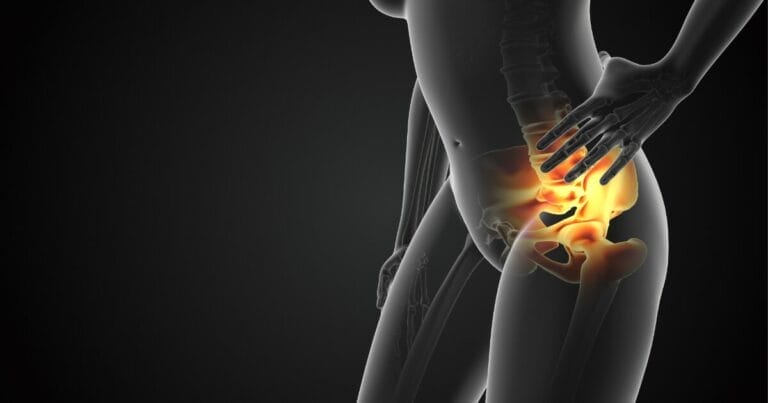Soothe Your Pelvic Muscle Discomfort Naturally at Home
Many people experience pelvic muscle discomfort, which can negatively affect their quality of life. This discomfort can be caused by various issues, including injuries or chronic conditions like pelvic floor dysfunction. People often prefer natural remedies that can be done at home to find relief from pelvic pain. If you’re looking for ways to manage…

Many people experience pelvic muscle discomfort, which can negatively affect their quality of life. This discomfort can be caused by various issues, including injuries or chronic conditions like pelvic floor dysfunction. People often prefer natural remedies that can be done at home to find relief from pelvic pain.
If you’re looking for ways to manage pelvic muscle discomfort naturally, you’re in the right place. Here’s a guide to help you begin your journey to relief:
Firstly, self-care is a great starting point. Simple relaxation techniques can provide comfort by reducing tension in the pelvic muscles.
Secondly, strengthening exercises for the pelvic floor can also be very beneficial. By improving muscle tone, you may find significant relief from pain.
Furthermore, adjusting your diet to include anti-inflammatory foods can support your pelvic health.
Let’s delve deeper into these strategies and explore how to incorporate them into your daily routine.
Remember that while these methods are helpful, it’s crucial to consult with a healthcare professional before starting any new regimen. They can help you understand the root cause of your discomfort and guide you towards the best solution for your situation.
In conclusion, managing pelvic muscle discomfort naturally is possible with the right self-care, exercises, and dietary changes. Embrace these strategies and begin your path to a more comfortable life.
‘Embrace the power of natural remedies and take control of your pelvic health with these simple, yet effective, strategies.’
Key Takeaways
If you’re struggling with pelvic muscle discomfort and seeking natural ways to alleviate it at home, you’ve found the right guide. Let’s skip the confusing medical jargon and dive straight into practical tips that can help.
Start with Self-Care: Simply relaxing can do wonders for your pelvic muscles. Engage in easy relaxation techniques to ease the tension.
Exercise Your Way to Relief: Targeted pelvic floor exercises can strengthen your muscles and reduce pain.
Eat Smart: Incorporate foods with anti-inflammatory properties into your meals to support pelvic health.
As you delve into these strategies, remember to check in with a healthcare professional. They’ll ensure you’re on the right track and that your efforts align with your specific needs.
To wrap it up, you can indeed manage pelvic muscle discomfort with everyday self-care, exercise, and diet tweaks. Start these habits, and you’re on your way to a more comfortable lifestyle.
“Take charge of your pelvic health with these straightforward and practical strategies.”
When considering these approaches, it’s key to remember their significance. Self-care provides solace, exercises enhance muscle function, and the right diet can support overall well-being. These steps are not just activities but are crucial for your health journey.
Let’s move on to specifics. For relaxation, consider gentle yoga or deep breathing exercises. When it comes to strengthening, kegel exercises are a go-to. And for your diet, think about adding turmeric, ginger, and omega-3 rich foods like salmon.
In this quick-paced world, it’s easy to overlook the basics of health. But with these tips and a conversation with your doctor, you’re well-prepared to tackle pelvic discomfort. Remember, it’s about finding what works for you and integrating it into your daily life.
Understanding Pelvic Pain Syndromes
Understanding Pelvic Pain Syndromes
Pelvic pain can be a real puzzle. It includes many different conditions that might cause sudden or ongoing pain in the lower belly and pelvic area. It’s tough for both patients and doctors to figure out. To really tackle these issues, it’s super important to know all about the pelvic area. This part of the body has vital organs for reproduction, peeing, and digestion, and they can all have problems that cause pain. Also, hormones have a big impact, especially with issues like endometriosis and pain during periods. Knowing the details of these conditions can help doctors find the right treatment, and it’s often necessary to use several methods to reduce this pain.
When diving into the realm of pelvic pain, it’s crucial to recognize that this area is a complex network, hosting essential systems that can be affected by various medical issues. Hormones, for example, play a significant role in managing pelvic pain, which is particularly true for conditions like endometriosis and menstrual pain. Understanding the intricacies of these conditions is the key to effective treatment, acknowledging that a combination of therapies is often needed for relief.
Understanding the Pelvic Puzzle
Imagine you’re trying to solve a puzzle, but the pieces are hidden in different parts of a treasure box. That’s a bit like dealing with pelvic pain. To unlock the secrets, a deep dive into pelvic anatomy is necessary. The pelvic area is a busy place where reproductive, urinary, and bowel systems live. They’re all close neighbors, so when one system has an issue, it can affect the others, leading to pain.
Why Hormones Matter
Remember that hormones are like messengers in your body, telling different parts what to do. In the pelvic region, they can be like a conductor for an orchestra, setting the rhythm for everything. When the rhythm is off, like with endometriosis or when someone is having their period, it can cause a lot of pain. That’s why understanding hormones is a big part of finding relief.
Combining Forces for Relief
It can be a daunting task to find solace from pelvic pain, but doctors know that one size doesn’t fit all. Just like a trailblazer in the wilderness, doctors need to explore different paths to find what works best. This could mean combining medications with physical therapy or other treatments. The goal is to enhance the quality of life for those dealing with this kind of pain.
Natural Pain Relief Strategies
For many individuals experiencing pelvic discomfort, incorporating natural pain relief strategies can provide significant relief without the need for pharmaceutical intervention. Understanding and utilizing therapies that align with the body’s inherent healing processes can be empowering and effective. With a focus on mastery, let’s explore several methods that can soothe pelvic muscle discomfort naturally:
- Herbal Supplements: Research supports the use of certain herbs with anti-inflammatory properties, such as turmeric and ginger, which can be beneficial in managing pelvic pain.
- Acupuncture Efficacy: Clinical studies suggest acupuncture can reduce pelvic pain by promoting circulation and balancing the body’s energy pathways.
- Heat Therapy: Applying a warm compress or taking a warm bath can relax muscles and alleviate pain.
- Mindfulness Meditation: Regular practice helps manage pain by reducing stress and enhancing body awareness.
- Physical Therapy: Tailored exercises improve pelvic floor muscle function and support pain reduction.
Self-Care Techniques for Managing Pelvic Muscle Pain
Embarking on a journey of self-care, individuals with pelvic muscle pain can employ a variety of techniques at home to manage and alleviate their discomfort.
Heat therapy emerges as a profoundly beneficial method, offering soothing relief by enhancing blood flow and relaxing tense muscles. Simple applications such as a warm bath or a heated pad placed strategically on the affected area can significantly reduce pain intensity.
Furthermore, exploring acupressure points presents another avenue for relief. This ancient practice involves applying pressure to specific points on the body, which can release muscular tension and promote healing.
Mastery of these self-care techniques requires patience and consistency, but with practice, individuals may experience substantial improvement in their pelvic muscle pain, enhancing their overall well-being.
Exercises to Strengthen the Pelvic Floor
Strengthening the pelvic floor muscles is a crucial step in mitigating discomfort and enhancing overall pelvic health. Kegel exercises, which involve the rhythmic contraction and relaxation of pelvic floor muscles, are foundational in building strength in this area.
Additionally, integrating deep breathing techniques can support the effectiveness of these exercises, promoting relaxation and increasing oxygen flow to the muscles.
Kegel Exercise Fundamentals
Kegel Exercise Essentials
Kegel exercises, initially recommended by Dr. Arnold Kegel, consist of straightforward muscle contractions aimed at fortifying the pelvic floor. To master these exercises, it’s vital to concentrate on the correct technique, because doing them wrongly can decrease their effectiveness and potentially cause discomfort. When using any devices to assist with Kegels, it’s imperative to adhere to the provided guidelines to prevent any issues.
- Identify the Pelvic Muscles: The muscles you use to halt the flow of urine are the ones you should engage during Kegel exercises.
- Practice Correct Technique: Emphasize an inward lift and squeeze while avoiding tensing unrelated muscle groups like the abdomen, buttocks, or thighs.
- Consistency is Key: Building muscle strength demands regular practice of the exercises.
- Increase Intensity Gradually: Begin with gentle muscle contractions and progressively intensify the exercise as your muscles get stronger.
- Breathe Normally: Make sure to breathe normally and avoid holding your breath while performing the exercises.
In today’s health-conscious society, understanding and maintaining your body’s strength is more important than ever. These exercises provide a simple yet effective method to ensure the health of your pelvic floor, which is crucial for both men and women. By including Kegel exercises in your routine, you can enhance your well-being and prevent future issues.
Remember that consistency will lead to better results, so make these exercises a regular part of your life.
Custom Quote: ‘Empower your body with Kegel exercises; a small step for your daily routine, a giant leap for your pelvic health.’
Deep Breathing Techniques
Deep breathing methods are a vital addition to Kegel exercises, enhancing pelvic floor muscles and easing discomfort in a non-surgical manner. By including mindful meditation in your daily activities, you can achieve a state of focus and relaxation that aids in managing stress and maintaining pelvic health. Deep breathing helps ease muscle tension, aiding recovery and reducing strain in pelvic muscles.
To get started, find a place where you won’t be disturbed and sit or lie down comfortably. Breathe in slowly through your nose, letting your belly expand, and then breathe out gently, taking note of how your pelvic muscles loosen. Making these breathing exercises a regular part of your life can help you skillfully handle any pelvic discomfort while also bolstering the connection between your mind and body.
Why Is This Important?
Practicing deep breathing offers numerous benefits, such as improving oxygen flow to your brain, which can boost concentration and reduce anxiety levels. It’s not just about physical health; it’s about improving your overall wellbeing.
Steps to Deep Breathing:
- Find Your Space: Choose a quiet area where you can relax without interruptions.
- Get Comfortable: Sit or lie down in a way that feels good for you.
- Breathe Deeply: Inhale through your nose and let your abdomen fully expand.
- Exhale and Relax: Breathe out slowly and feel your pelvic muscles release tension.
- Regular Practice: Incorporate this into your routine to manage pelvic discomfort and strengthen your mind-body link.
Conclusion
Incorporating deep breathing into your life is a simple yet powerful way to improve your pelvic health and overall relaxation. With regular practice, you’ll likely notice a difference in how you manage stress and physical discomfort.
Diet and Nutrition for Pelvic Health
Optimal pelvic health is significantly influenced by one’s dietary choices, which can either soothe or exacerbate discomfort. Incorporating anti-inflammatory foods into one’s diet can play a pivotal role in reducing pelvic muscle inflammation and associated pain.
Moreover, maintaining proper hydration is essential for overall pelvic function and can aid in alleviating symptoms associated with pelvic floor disorders.
Anti-Inflammatory Food Choices
Eating foods that fight inflammation is key to easing discomfort in the pelvic muscles and boosting your overall pelvic health. It’s essential to lower inflammation in the body to manage pain effectively. For instance, the natural compounds in turmeric are known for their strong anti-inflammatory effects. By choosing the right foods, you have the power to influence the inflammatory response in your body and potentially find some comfort from pelvic pain.
- Omega-3 Rich Fish: If you’re after omega-3 fatty acids with their inflammation-busting properties, look no further than salmon, mackerel, and sardines.
- Leafy Greens: Turn to spinach and kale for their wealth of antioxidants and polyphenols that can help your body fight inflammation.
- Berries: A bowl of blueberries, strawberries, or raspberries can offer you the anti-inflammatory flavonoids your body craves.
- Nuts: Snack on almonds and walnuts when you need a boost of healthy fats and vitamin E, both allies in your fight against inflammation.
- Whole Grains: Incorporate brown rice and quinoa into your meals as they can play a role in reducing inflammation.
Remember that making smart food choices is not just about following trends; it’s about finding what works for your body. And who knows? You might just discover that these foods not only ease your pain but also become your new favorites.
Custom Quote: ‘Let food be the change in your health journey; embrace the power of anti-inflammatory choices to transform your well-being.’
Hydration’s Role in Health
Staying hydrated is crucial for your health, especially when it comes to keeping your pelvic area in good shape and easing any muscle pains. When you drink enough water, your pelvic tissues stay moist and work better, which means you’re less likely to have pain or swelling. Water also helps keep your urinary system healthy by making your urine less concentrated, which lowers your risk of getting urinary tract infections or kidney stones that can make pelvic pain worse.
For these health perks, it’s important to drink plenty of water every day. The exact amount you need depends on things like how active you are and the climate you live in. Focusing on hydration is a smart way to take care of your pelvic health and feel your best overall.
Remember that hydration is more than just drinking water; it’s about listening to your body and giving it what it needs. So, start your day with a glass of water and keep a bottle with you to sip from throughout the day. This simple habit can have a big impact on your health and comfort.
And here’s a little nugget of wisdom to keep in mind: ‘Hydration is the key to unlocking a pain-free pelvis.’ Drink up and thrive!
When to Seek Professional Pelvic Floor Therapy
If home treatments aren’t easing your pelvic muscle pain, it might be time to get help from a pro. You’ll especially want to consider this if you’ve been trying to manage the pain on your own but it’s still hanging around, or if it’s getting worse and starting to mess with your day-to-day life. Professional pelvic floor therapy is also a smart move for those recovering from surgery in the pelvic area or if you’re having bathroom troubles that aren’t getting better with exercises you do at home.
Now, if sex is painful and your go-to fixes aren’t cutting it, or you notice something’s off like a pelvic organ prolapse, these are clear signals to get checked out by a specialist in pelvic health. They can give you a thorough check-up and create a treatment plan that’s just for you.
Remember that getting the right help is key to feeling better and getting back to your normal routine. Don’t hesitate to reach out to a healthcare provider who knows their stuff when it comes to pelvic health. They’ll guide you through your options and make sure you’re on the path to recovery.
Maintaining Pelvic Health: Preventative Measures
To keep your pelvic area healthy and avoid discomfort, it’s essential to be proactive. Start with regular exercises that focus on strengthening the pelvic floor muscles. These exercises do more than just improve muscle function; they also help keep your pelvis properly aligned, which is important for your overall health. When your pelvis is aligned, it prevents extra strain and helps everything work together smoothly.
Also, it’s important to keep your hormones in check, as they can impact muscle strength and flexibility, which may cause discomfort. Eating well, staying active, and managing stress can help keep your hormones balanced. By taking these steps, you can take charge of your pelvic health and reduce the chance of future problems.
Let’s delve into this further. Firstly, if you’re looking for exercises to strengthen your pelvic floor, look no further. There are plenty of resources available to help you get started.
Secondly, remember that a balanced diet isn’t just about weight; it’s also about giving your body the nutrients it needs to function well, including maintaining healthy muscles and hormones.
Recognizing Signs of Improvement
Maintaining pelvic health is critical, and noticing signs of improvement shows that your efforts are working. For those working hard to reduce pelvic discomfort, here’s what to look out for:
- You’ll find that the pain you’ve been tracking is steadily lessening.
- You’re sleeping better and waking up energized.
- Your daily activities are increasing without making your symptoms worse.
- There’s noticeable improvement in how your bladder and bowels function.
- And your flexibility and comfort during exercise are on the rise.
These positive changes are a direct reflection of your commitment to managing your health at home. By keeping an eye on these indicators, you can measure the success of your methods and make any necessary adjustments.
When you’re dedicated to improving your health, it’s important to celebrate these milestones. They’re not just signs of progress but also encourage you to keep going. Keep tracking, keep adjusting, and keep moving forward on your journey to better health.
Frequently Asked Questions
Can Changes in Weather or Climate Affect My Pelvic Muscle Discomfort?
Weather changes can indeed affect your pelvic muscle discomfort. When the atmospheric pressure shifts, it might make your symptoms worse. To keep yourself comfortable, it’s important to get used to different weather conditions.
Firstly, let’s talk about why this happens. The pressure in the air can impact your body, and some people are more sensitive to these changes than others. If you find that your pelvic muscles start hurting more when the weather changes, it’s not just in your head. This is a real phenomenon.
Now let’s move on to what you can do about it. It’s essential to find ways to adapt to the changing climate to manage your pain. This might mean dressing warmly on cold days or using a humidifier when it’s dry. Simple adjustments can make a big difference in how you feel.
Remember that staying informed about the weather and being proactive with your comfort can help minimize discomfort. Keep an eye on the forecast and plan accordingly. And if you’re looking for more strategies to alleviate pelvic muscle discomfort, consider talking to a healthcare provider who can offer personalized advice for your situation.
How Might My Menstrual Cycle or Hormonal Changes Impact Pelvic Muscle Pain?
Hormonal fluctuations during the menstrual cycle can exacerbate pelvic muscle pain. Diet adjustments and hormonal therapy may offer relief, addressing symptoms with precision and empathy for those seeking comprehensive understanding and management strategies.
Are There Any Alternative Therapies, Such as Acupuncture or Cupping, That Can Help With Pelvic Muscle Discomfort?
Alternative therapies like acupuncture could provide relief for those suffering from pelvic muscle discomfort. Adding yoga stretches and herbal treatments can also help, as they treat the symptoms with a comprehensive and understanding approach that takes individual needs into account.
When looking for ways to alleviate pelvic muscle discomfort, acupuncture stands out as a noteworthy option. It’s a practice that has been used for centuries and can offer a sense of relief for many. To complement acupuncture, incorporating yoga can enhance flexibility and strength, which may reduce discomfort. Herbal remedies, tailored to each person’s specific needs, can also play a role in managing symptoms.
It’s essential to approach health issues with a full understanding of the available treatments. While acupuncture and yoga are beneficial, it’s important to consult with a healthcare professional to ensure these therapies are appropriate for your specific situation.
What Role Does Stress Play in Pelvic Muscle Pain, and Can Mindfulness or Meditation Make a Difference?
Stress can make pelvic muscle pain worse by increasing tension in the area. By learning and practicing stress management and relaxation methods like mindfulness or meditation, people can greatly reduce their discomfort. These approaches provide a non-surgical way to gain control over pelvic muscle pain.
Reflecting the fast-paced nature of our daily lives, it is crucial to find effective ways to manage stress. Clear and simple, mindfulness or meditation can be powerful tools in the battle against pelvic muscle pain. Instead of relying on clichés, let’s explore why these techniques are beneficial.
When the body is under stress, it naturally tightens up, and the pelvic muscles are no exception. This can lead to increased pain. However, by engaging in mindfulness or meditation, individuals can learn to relax these muscles, which can lead to a reduction in pain. By thoughtfully integrating these practices into daily routines, a natural rhythm of stress relief can be established.
Using the active voice for clarity: Practicing mindfulness or meditation actively reduces stress and can alleviate pelvic muscle pain.
We avoid hyperbole and instead focus on the evidence that supports the benefits of these relaxation techniques. For example, studies have shown that regular meditation can decrease the body’s response to stress, which may, in turn, reduce muscle tension and pain.
In a conversational style, imagine you’re talking to a friend who’s dealing with this kind of pain. You might suggest, “Have you thought about trying meditation? It’s helped a lot of people manage their stress and reduce muscle pain.”
Mindfulness and meditation are not just buzzwords; they are practical, accessible strategies that can improve your well-being.
Can Sexual Activity Worsen or Improve Pelvic Muscle Discomfort, and Are There Specific Considerations to Keep in Mind?
The effects of sexual activity on pelvic muscle discomfort are not one-size-fits-all. Engaging in pelvic exercises may help ease tension, and choosing certain positions during intimacy could lessen the pressure. It’s critical to adjust these activities based on what feels right and comfortable for the individual.
Sexual activity can either aggravate or soothe pelvic muscle pain, depending on the person. Simple pelvic floor exercises might provide relief by relaxing tense muscles. On the other hand, opting for specific sexual positions can decrease discomfort by minimizing stress on the area. It’s essential for each person to figure out what works best for them and to proceed with activities that align with their comfort level and physical capabilities.
Remember that communication with a partner and possibly a healthcare provider can be invaluable in finding what practices are most beneficial for managing pelvic muscle discomfort. And don’t forget, it’s equally important to listen to your body and pace yourself according to your personal limits and sensations.







